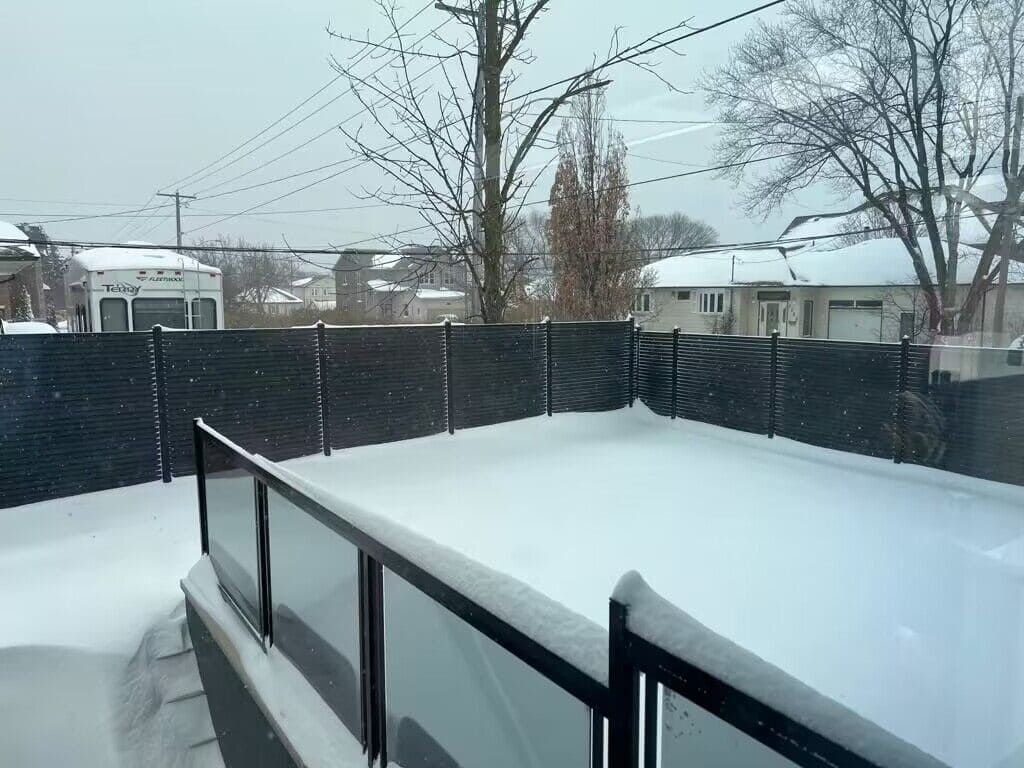Estimated reading time: 6 分钟

As winter approaches, the cold is more than just uncomfortable—it’s a serious threat to your fence. Freezing temperatures, heavy snow, and ice can challenge the integrity of any barrier. To safeguard your investment, it’s essential to understand how different fence materials—wood, PVC, and wood-plastic composite (WPC)—react to winter conditions.
This guide provides professional maintenance tips, drawing on insights from materials science to help your fence survive the cold.
The Cold-Weather Challenge: Material-Specific Risks
Understanding how cold impacts each material is the foundation of proper maintenance. Tests on material properties reveal distinct risks for each type of fence:
Wooden Fences: Impact of Temperature on Strength and Durability
- The Risk: Wood is highly vulnerable to temperature fluctuations. Cold causes the material to contract, often resulting in hairline cracks and splits. If moisture from melting snow penetrates unsealed wood, the freeze-thaw cycle rapidly accelerates rot and decay.
- The Science: While wood-based materials can see an increase in compressive strength at lower temperatures (Xi & Zhao, 2022), this structural benefit is undermined by the material’s increased fragility and its natural susceptibility to moisture damage. Proper sealing is mandatory.
PVC Fences: Brittleness at Low Temperatures
- The Risk: While generally low-maintenance, PVC becomes significantly more brittle as temperatures drop below freezing. This material can easily crack under stress, especially from the weight of snow or an accidental impact during yard work.
- The Science: Studies confirm that the impact strength of materials like acrylate-modified PVC significantly decreases in colder temperatures (Hassan & Haworth, 2005). Inspection and gentle handling are vital to prevent damage that can expand rapidly in freezing conditions.
Composite(WPC) Fences: The Temperature-Dependent Strength of Composites
- The Risk: Composites generally hold up well, but they are not immune to extreme cold. They can still become brittle, requiring careful snow and ice removal.
- The Science: Composite material exhibits a unique behavior: its compressive strength often improves when it gets colder (Xi & Zhao, 2022). This temperature-dependent benefit is based on the material remaining structurally sound. Maintenance should focus on preventing the minor cracks that could compromise this integrity.
Preparing Your Fence for Winter: Expert Recommendations
Proper maintenance in the fall is key to ensuring that your fence withstands the winter months. Let’s go over some expert tips, backed by scientific findings, on how to winterize your fence.
A. Cleaning and Inspecting the Fence
- All Fences: A thorough cleaning is the first step. Use mild soap and water to remove dirt, mildew, or moss, preventing surface stains that can worsen under snow and ice.
- WPC & PVC: During inspection, look closely for any existing cracks, chips, or breaks. These small flaws are points of weakness that the cold will quickly exploit and expand.
B. Sealing and Protecting the Material
- Wooden Fences: Apply a high-quality, protective wood sealant or stain. This is the single most important action to prevent moisture penetration and preserve the wood’s structural integrity against contraction and rot.
- PVC & WPC Fences: Avoid using harsh chemicals or corrosive de-icing agents near the fence base, as these can weaken or discolor the material. While WPC is naturally resistant to moisture, ensuring proper seals around posts helps maintain its optimal performance.
C. Reinforce and Trim Surrounding Plants
- Trim Branches: Remove any overhanging branches or dead limbs. The weight of a small layer of ice or wet snow can turn a simple branch into a projectile that can severely damage your fence panels.
- Clear Vines: Remove dense vines or climbing plants, which trap moisture against the fence surface and can cause significant strain under the added weight of snow.
Winter-Specific Maintenance Tips
A. Regular Snow and Ice Removal
When clearing snow, be mindful of the material’s condition in the cold:
- Avoid Piling: Never shovel or blow large amounts of snow against the fence line; the excessive strain can compromise the structure.
- Use the Right Tool: For PVC and WPC fences, use a plastic shovel to remove snow directly against the panels. The use of metal tools dramatically increases the risk of scratching, chipping, or causing cracks in the brittle, cold material.
B. Inspect and Repair Damage Promptly
- Immediate Action: After any heavy snow or freezing event, quickly inspect your fence. If you find small cracks, repair them immediately. Early intervention is crucial, especially for PVC, where cracks can spread rapidly in sustained cold.
- Spring Assessment: Once the last frost has passed, perform a final, detailed inspection. Check for loose panels, damaged hardware, and any signs of material degradation caused by the winter stress.
Long-Term Protection: Maintaining Fence Integrity Beyond Winter
Wooden Fences: In spring, thoroughly inspect for weather-related damage, rot, or swelling that occurred over winter. Reapply any necessary protective coatings.
PVC and WPC Fences: While requiring less overall maintenance, periodic checks for cracks after a particularly cold winter will help extend their life. Remember that despite their durability, both materials need extra care during and immediately after harsh winter weather.
Conclusion
Winter can be tough on your fence, but with the right care and maintenance, you can ensure its longevity through the cold months. Whether you have a wooden, PVC, or WPC fence, following the material-specific advice backed by experimental tests will protect your investment. Take the necessary steps now to safeguard your fence and enjoy peace of mind through the winter season.



